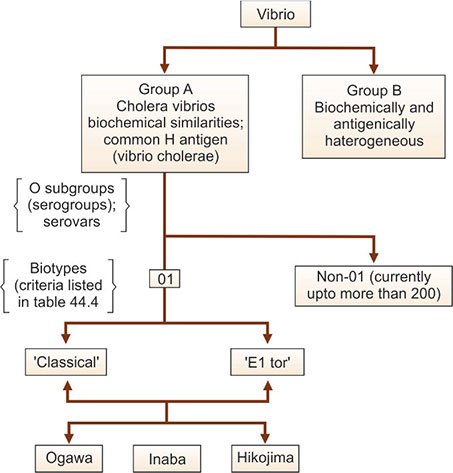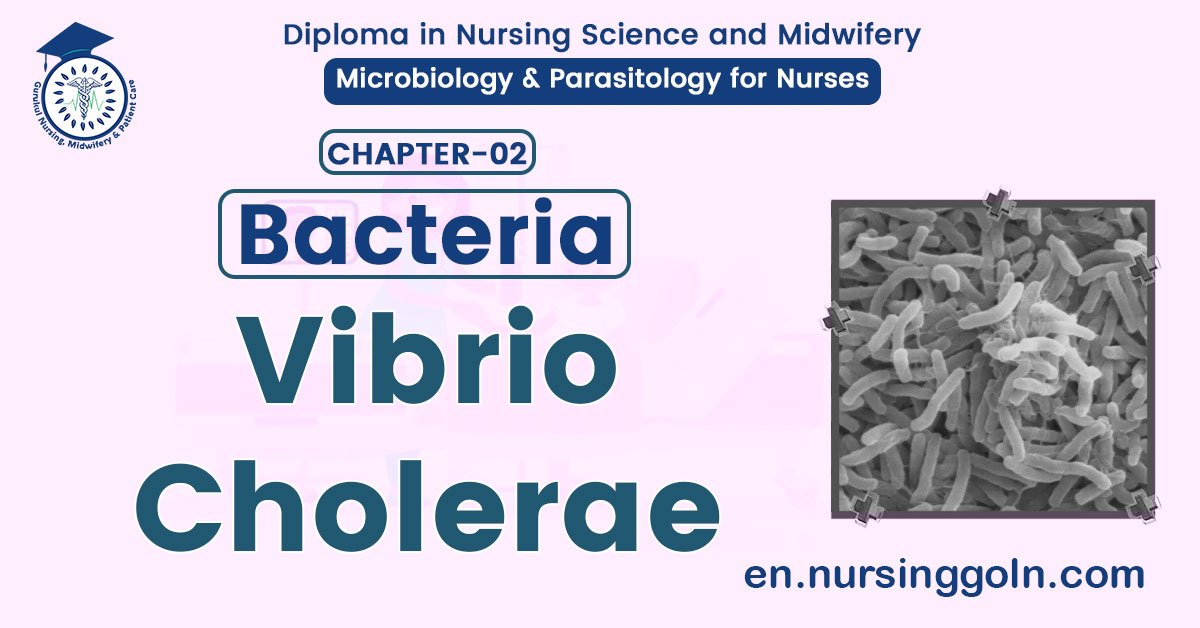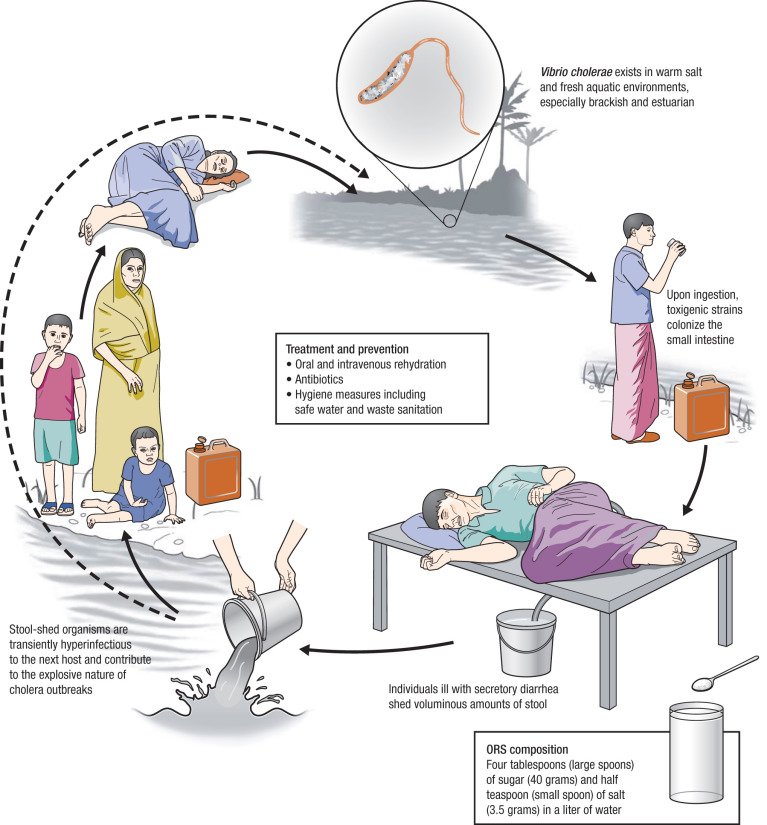Vibrio Cholerae – Basic microbiology, parasitology, and immunology; nature, reproduction, growth, and transmission of common microorganisms and parasites in Bangladesh; prevention including universal precaution and immunization, control, sterilization, and disinfection; and specimen collections and examination. Students will have an understanding of common organisms and parasites caused human diseases and acquire knowledge about the prevention and control of those organisms.
Vibrio Cholerae
Definition of Cholera:
Cholera is a bacterial disease usually spread through contaminated water. Cholera causes severe diarrhea and dehydration. Left untreated, cholera can be fatal in a matter of hours, even in previously healthy people.
or
This is an acute communicable disease, caused by Vibrio Cholera. The incubation period is from a few hours to 2 days. The organisms are swallowed with contaminated food and water. In the small intestine they quickly multiply and produce a toxin which causes the intestinal wall to secrete a great deal of water and salts.

Properties of Vibrio Cholerae:
- Gram-negative.
- Curved, comma-shaped rods.
- Actively motile by means of a single polar flagellum.
- In hanging drop preparation have a ‘fish- in stream appearance.
- Facultative anaerobe.
- Most species are oxidase-positive
- Non-sporing and non-capsulated.
Culture and Growth Characteristics of Vibrio Cholerae:
- Aerobe. Optimum temperature is 37°C
- Aerobe. Optimum temperature is 37°C
- Grow on ordinary media
- On Monsur’s media (Tellurite gelatin agar media): Dark colonies with characteristic Wan hollows around them.
- On Mac Conkey’s agar: Ferments lactose slowly (colourless/pale colonies).
- On nutrient agar: Circular, smooth and translucent colonies
- Alkaline peptone water.
Pathogenesis of Cholera:
Fecal contamination of water & food with Vibrio cholerae
↓
Ingestion of contaminated water or food (containing at least 108 Vibrio cholerae)
↓
Organisms pass the acid barrier of stomach & reach the alkaline environment of small intestine
↓
Organisms pass the acid barrier of stomach & reach the alkaline environment of small intestine
↓
Protective glycoprotein coat of intestinal cells is dissolved
↓
Adherence of the organisms to the cells of the brush border of the gut & multiplication
↓
Secretion of enterotoxin called choleragen [consists of 2 subunit, a A (active) subunit & a B
↓
Subunit B binds to a ganglioside receptor on enterocyte & subunit A enters into the cell.
↓
Persistent stimulation of the enzyme adenylate cylase and overproduction of cAMP
↓
Increased secretion of Cl & H20
↓
Massive watery diarrhoea and vomiting.
Lab. Diagnosis of Cholera:
Principle:
It is based on demonstration of Vibrio cholerae by microscopic examination. Isolation and identification is done by bacteriological techniques. Biochemical and serological tests are also helpful.
Steps
➤ Specimen collection:
- Stool
- Vomit
- Rectal swab
First day
➤ Microscopic examination:
- Gram staining: Gram-negative comma shaped bacilli.
- Hanging drop preparation: Typical motility (‘a fish in stream’ appearance).
- Dark ground illumination (DGI): Shooting star in dark sky appearance.
➤ Isolation and culture:
- Monsur’s media (Tellurite taurocholate gelatin agar media): Small black colonies surrounded by characteristic hollows.
- Thiosulphite-Citrate-Bile-Sucrose agar (TCBS agar): Large yellow coloured colony.
➤ Biochemical tests: Oxidase-positive.
Second day and onwards:
➤ Serological tests:
- Slide agglutination test (mostly used).
- Indirect haemagglutination test
- ELISA
Management of Cholera:
A. Clinical feature
a) Symptoms
- Watery diarrhea (sometimes in large volumes)
- Rice-water stools.
- Fishy odor to stools
- Vomiting
- Rapid heart rate
- Loss of skin elasticity
- Dry mucous membranes (dry mouth)
- Low blood pressure
- Thirst
- Muscle cramps (leg cramps, for example)
- Restlessness or irritability (especially in children)
- Unusual sleepiness or tiredness
Other symptoms that may occur, especially with more severe disease, include the following:
- Abdominal pain (cramps)
- Rectal pain
- Fever
- Severe vomiting
- Dehydration
- Low or no urine output
- Weight loss
- Seizures
- Shock
- Death
b) O/E
- Dehydration- present.
- Shock may be present:
✓ Cold & clammy skin
✓ Rapid thready halse
✓ Hypotension
- Eyes- Shunken
- Coma, confusion and death may occur from circulatory failure.
B. Investigation:
a) Stool for R/M/E (Dark field microscopy) – shooting star motility of Vibrio cholera
b) Culture of stool or rectal swab.
C. Treatment:
a) Assessment of dehydration & IV channel open.
- Correction of fluid & electrolyte by IV:
✔ Ringer’s lactate
✔ Cholera saline
✔ Hartman’s solution.
- After blood pressure and pulse is stable, rest of the estimated deficit replacement slowly by ORS.
- Total fluid requirement is calculated every 8 hourly from urine volume, stool & vomit output and insensible loss (5 L/ day in hot climate)
- Total fluid requirement may exceeds 50 litres over 2-5 days.
b) Tetracycline 250 mg 6 hourly
Ог,
Doxicycline 300 mg a single dose
Or,
Ciprofloxacin 1 gm daily.
c) Rx of renal failure if already developed.
Causes of Cholera
- Food poisoning (Salmonella)
- Campylobacter jejuni infection.
- E. coli
- Shigella
- Giardia
- Amoeba
- Rota virus

Difference between Diarrhea and Cholera
| Traits | Diarrhea | Cholera |
| 1. Causative organisms | Diarrhea is caused by bacteria, viruses and parasites, which is due to unwise drinking / eating. | Cholera is caused by vibrio cholera. |
| 2. Transmission | Diarrhea is transmitted through impure food and water. | Cholera is transmitted through infected food and water plus direct contact with feces and vomitus. |
| 3. Stages | Diarrhea is not divided into stages but acute and chronic forms. | Cholera has two stages i.e. stage of evacuation and stage of collapse. |
| 4. Diagnosis | Diarrhea is purely a clinical disease but stool examination is carried out to determine the cause. | Cholera is diagnosed through presence of vibrio cholera in stools, culture of stools or rectal swabs. |
| 5. Treatment | Diarrhea is a self-limiting disease is treated through fluid and electrolyte replacement. | In cholera, along with fluid and water replacement, antibiotics like ciprofloxacin and tetracycline are given. |
| 6. Prevention/ Vaccination | There is no vaccination against diarrhea but only hygienic conditions cause improvement. | Vaccination is present for cholera |
Read More….

